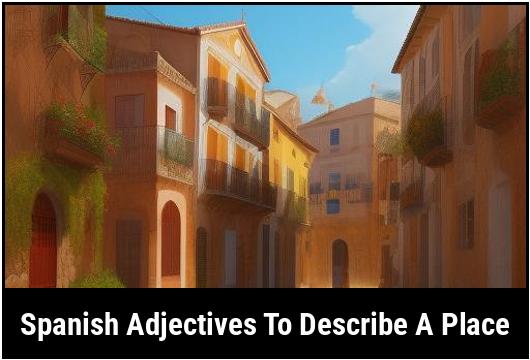- You are here:
- Home »
- adjectives
- » 31 Spanish Adjectives To Describe A Place

31 Spanish Adjectives To Describe A Place
In the Spanish language, adjectives play a crucial role in painting a vivid picture of a place. Whether you want to convey the beauty of a scenic landscape, the charm of a quaint village, or the bustling energy of a city, using the right adjectives can bring your descriptions to life. This article aims to delve into the various types of Spanish adjectives used to describe a place, providing insights into their usage and nuances.
Key Takeaways
- Spanish adjectives are essential for enhancing the description of a place, allowing for a more detailed and immersive narrative.
- Adjectives in Spanish change according to the gender and number of the noun they modify, making it crucial to understand their agreement.
- Understanding the subtleties of different types of adjectives can help in accurately conveying the specific characteristics of a place.
Spanish Adjectives To Describe A Place
1. Hermoso/a
The adjective "hermoso/a" is used to describe places of exquisite beauty. Its counterpart in English is "beautiful." Whether it’s a breathtaking mountain range or a stunning architectural masterpiece, this adjective perfectly captures the splendor of a place.
2. Pintoresco/a
"Pintoresco/a" is the Spanish adjective for "picturesque." It refers to places that are visually pleasing, often reminiscent of a painting. It is often used to describe charming villages or scenic landscapes that have a unique and enchanting quality.
3. Animado/a
For places that are lively and bustling with activity, the adjective "animado/a" is employed. In English, it translates to "animated" or "lively." This adjective is perfect to describe vibrant cities with busy streets and a vibrant nightlife.
4. Tranquilo/a
When it comes to serene and peaceful places, the adjective "tranquilo/a" comes to mind. It is the Spanish equivalent of "tranquil" or "calm." Whether it’s a secluded beach or a quiet countryside, this adjective evokes a sense of tranquility and relaxation.
5. Histórico/a
The adjective "histórico/a" is used to describe places of historical significance. It is synonymous with "historical" in English. When we think of iconic landmarks or ancient ruins, this adjective is the perfect choice to capture the historical essence of a place.
6. Moderno/a
"Moderno/a" is the Spanish adjective for "modern." It is used to describe places that embrace contemporary architecture, technology, and design. Whether it’s a futuristic skyscraper or a sleek museum, this adjective is fitting to describe the cutting-edge aspects of a place.
7. Romántico/a
To describe places that exude romance and passion, the adjective "romántico/a" is used. It translates to "romantic" in English. Be it a candlelit restaurant or a picturesque sunset viewpoint, this adjective perfectly encapsulates the romantic atmosphere of a place.
8. Exótico/a
When it comes to places that are unique and exotic, the adjective "exótico/a" fits the bill. It is synonymous with "exotic" in English. Whether a tropical island or a vibrant bazaar, this word conveys the allure and intrigue of a place that is far from the ordinary.
9. Acogedor/a
"Acojedor/a" is used to describe places that are warm, cozy, and welcoming. Its English counterpart is "cozy" or "homely." Whether it’s a charming little café or a comfortable cabin in the mountains, this adjective describes spaces that make you feel at home.
10. Impresionante
For places that leave you in awe and admiration, the adjective "impresionante" is the perfect choice. Translating to "impressive" in English, this word is often used to describe breathtaking natural wonders, architectural marvels, or any place that evokes a sense of awe-inspiring grandeur.
11. Agradable
"Agradable" is the Spanish adjective for "pleasant" or "agreeable." It is used to describe places that provide a delightful and enjoyable experience. From charming parks to quaint markets, this word characterizes places that bring joy and contentment.
12. Lujoso/a
When it comes to extravagant and luxurious places, the adjective "lujoso/a" is the ideal descriptor. Its English translation is "luxurious" or "opulent." Whether it’s a lavish hotel or an upscale shopping district, this word conveys the lavishness and elegance associated with a place.
13. Tradicional
To describe places that embrace tradition and cultural heritage, the adjective "tradicional" is commonly used. It is analogous to "traditional" in English. From centuries-old festivals to historic neighborhoods, this word captures the essence of a place deeply rooted in tradition.
14. Único/a
"Único/a" is an adjective that signifies uniqueness and singularity. Its English equivalent is "unique." It is used to describe places that are one-of-a-kind and cannot be replicated. Whether it’s an extraordinary natural formation or a remarkable architectural masterpiece, this word sets a place apart from the rest.
15. Famoso/a
The adjective "famoso/a" is used to describe places that are famous and well-known. Its English translation is "famous." Whether it’s an iconic landmark or a renowned city, this word captures the widespread recognition and popularity of a place.
16. Divertido/a
For places that are fun, lively, and entertaining, the adjective "divertido/a" is the perfect choice. It translates to "fun" or "entertaining" in English. Whether it’s a theme park or a vibrant nightlife district, this adjective encapsulates the enjoyment and excitement a place has to offer.
17. Encantador/a
To describe places that are charming and enchanting, the adjective "encantador/a" is ideal. It is synonymous with "charming" in English. Whether it’s a quaint village or a hidden gem, this word captures the captivating and enchanting nature of a place.
18. Prístino/a
The adjective "prístino/a" is used to describe places that are pristine and untouched. Its English counterpart is "pristine." Whether it’s an untouched white-sand beach or a remote mountain range, this adjective evokes a sense of purity and unspoiled nature.
19. Espacioso/a
When it comes to places that are spacious and roomy, the adjective "espacioso/a" is employed. Its English translation is "spacious." From sprawling gardens to expansive plazas, this word conveys the abundance of space that a place offers.
20. Cultural
The adjective "cultural" is used to describe places that are rich in culture and heritage. It is analogous to its English translation. From museums to historical sites, this word characterizes places that celebrate and preserve cultural treasures.
21. Pequeño/a
For places that are small and quaint, the adjective "pequeño/a" fits perfectly. Translating to "small" in English, this word is often used to describe charming cafes, narrow alleyways, or cozy shops that captivate visitors with their intimate charm.
22. Espiritual
The adjective "espiritual" is employed to describe places that have a spiritual or transcendental atmosphere. It is similar to "spiritual" in English. Be it a sacred temple or a serene meditation retreat, this word evokes the spiritual essence of a place.
23. Auténtico/a
To describe places that are authentic and genuine, the adjective "auténtico/a" is the perfect choice. Its English translation is "authentic." Whether it’s an unspoiled village or a local food market, this word conveys the true essence and originality of a place.
24. Sereno/a
The adjective "sereno/a" is used to describe places that are calm, peaceful, and serene. It is akin to "serene" in English. From tranquil lakes to secluded gardens, this word captures the soothing and tranquil atmosphere of a place.
25. Movido/a
For places that are vibrant and bustling with activity, the adjective "movido/a" is employed. It is synonymous with "lively" or "busy" in English. Be it a crowded marketplace or a lively street festival, this word characterizes places that are filled with energy and movement.
26. Montañoso/a
The adjective "montañoso/a" is used to describe places that are mountainous and have lofty peaks. It translates to "mountainous" in English. From jagged cliffs to snow-capped summits, this word evokes the majestic beauty of mountainous landscapes.
27. Encantador/a
To describe places that are captivating and spellbinding, the adjective "encantador/a" is the perfect choice. It is akin to "enchanting" in English. Whether it’s a fairy-tale castle or a magical garden, this word captures the captivating and mesmerizing qualities of a place.
28. Soleado/a
The adjective "soleado/a" is used to describe places that are sunny and bathed in sunlight. Its English counterpart is "sunny." Be it a golden beach or a vibrant city square, this word conveys the sunny and cheerful nature of a place.
29. Ruidoso/a
When it comes to places that are noisy and bustling, the adjective "ruidoso/a" is employed. It is similar to "noisy" or "loud" in English. From crowded markets to lively plazas, this word captures the vibrant and spirited atmosphere of a place.
30. Fascinante
For places that are fascinating and captivating, the adjective "fascinante" fits perfectly. It translates to "fascinating" in English. Whether it’s an intriguing museum or a mysterious cave, this word captures the allure and curiosity a place can evoke.
31. Encantador/a
To describe places that are delightful and charming, the adjective "encantador/a" is the ideal choice. It is synonymous with "delightful" in English. Be it a cozy café or a vibrant street lined with colorful houses, this word characterizes places that are enchanting and fascinating.
Why Use Adjectives To Describe A Place
Adjectives are indispensable in capturing the essence and ambiance of a place. They provide depth and detail to descriptions, offering a more comprehensive understanding of the place being depicted. Whether it’s a serene countryside, a bustling metropolis, or a tranquil beach, adjectives enable the writer or speaker to evoke emotions and imagery, ensuring that the audience can visualize and appreciate the place being described.
Additionally, adjectives can help to highlight the unique features and characteristics of a place, allowing for a more nuanced portrayal. They can convey the climate, scenery, architecture, culture, and overall vibe, enabling the audience to form a complete mental picture and sensory experience.
How To Choose The Right Adjective To Describe A Place
Selecting the appropriate adjectives to describe a place requires a thoughtful consideration of the specific qualities, attributes, and ambiance that one wishes to convey. When choosing adjectives, it is essential to take into account aspects such as the landscape, architecture, atmosphere, and cultural significance of the place.
Understanding the gender and number agreement of adjectives is also crucial in Spanish. Adjectives modify nouns, and their form changes to match the gender (masculine/feminine) and number (singular/plural) of the noun they describe. This agreement ensures concordance and coherence in the description.
Moreover, considering the emotional impact and the overall impression one wants to convey is essential when selecting adjectives. Whether aiming to emphasize the vibrancy of a city or the tranquility of a rural setting, the choice of adjectives should align with the intended tone and mood of the description.
Types Of Adjectives For Describing Place
Descriptive Adjectives
Descriptive adjectives are fundamental in providing detailed and vivid descriptions of a place, highlighting its physical attributes and characteristics. In Spanish, these adjectives are used to depict the appearance, size, shape, color, and other visual qualities of a place, enabling the audience to form a mental image. Examples of descriptive adjectives include "hermoso" (beautiful), "pintoresco" (picturesque), "espacioso" (spacious), and "rústico" (rustic).
Emotive Adjectives
Emotive adjectives evoke feelings and emotions associated with a place, contributing to the overall mood and sentiment of the description. These adjectives allow the speaker or writer to convey the ambiance, atmosphere, and the emotional impact of the place on its visitors or inhabitants. Spanish emotive adjectives such as "mágico" (magical), "acogedor" (cozy), "apacible" (peaceful), and "emocionante" (exciting) add depth and sentiment to the depiction of a place.
Cultural Adjectives
Cultural adjectives are instrumental in representing the cultural essence, heritage, and traditions associated with a place. These adjectives convey the historical significance, artistic influences, and the cultural richness of a location, offering insights into its identity and legacy. Spanish cultural adjectives such as "histórico" (historic), "folclórico" (folkloric), "tradicional" (traditional), and "artístico" (artistic) are used to describe the cultural tapestry and heritage of a place.
Geographical Adjectives
Geographical adjectives are utilized to describe the physical features, topography, and natural landscapes of a place. These adjectives capture the geographic diversity, climate, and ecological characteristics, enabling the audience to envision the natural surroundings and environmental traits of the location. Spanish geographical adjectives like "montañoso" (mountainous), "costero" (coastal), "fértil" (fertile), and "templado" (temperate) convey the geographical attributes and natural beauty of a place.
Architectural Adjectives
Architectural adjectives are employed to depict the structural design, architectural styles, and built environment of a place. These adjectives convey the architectural splendor, historical significance, and urban layout, offering insights into the visual and aesthetic elements of the location. Spanish architectural adjectives such as "moderno" (modern), "antiguo" (ancient), "barroco" (baroque), and "neoclásico" (neoclassical) articulate the architectural characteristics and visual identity of a place.
Comparative Adjectives
Comparative adjectives are used to compare and contrast the characteristics of a place with others, providing a relative evaluation of its attributes. These adjectives facilitate the comparison of different places in terms of size, beauty, infrastructure, or any other distinguishing features. Spanish comparative adjectives like "más grande" (bigger), "menos bullicioso" (less bustling), "tan encantador como" (as charming as), and "más pintoresco que" (more picturesque than) enable the speaker to draw comparisons between different places, emphasizing their unique traits.
The use of adjectives is paramount in effectively describing a place in Spanish. Adjectives not only enrich the narrative by providing detailed and nuanced descriptions but also allow for the conveyance of emotions, sentiments, and cultural facets associated with the place. By employing descriptive, emotive, cultural, geographical, architectural, and comparative adjectives, speakers and writers can paint a vibrant and comprehensive picture of any place, ensuring that the audience can immerse themselves in the imagery and ambiance being portrayed. Understanding the nuances of these adjectives and their gender and number agreement is essential in accurately capturing the essence and identity of a place. Mastering the art of selecting and using Spanish adjectives to describe a place can significantly enhance the richness and evocativeness of the language, enabling effective communication and portrayal of diverse settings and environments.
Examples Of Adjectives For Different Types Of Place
In the Spanish language, adjectives play a significant role in expressing and describing the characteristics of a place. Whether you are talking about a bustling city, a serene beach, or a majestic mountain range, adjectives can help you paint a vivid picture and convey your thoughts accurately.
1. Cities
Cities are vibrant, bustling places that often have their own unique charm. Here are some Spanish adjectives that can be used to describe cities:
- Animado/a (lively): Una ciudad animada con una vibrante vida nocturna (A lively city with a vibrant nightlife).
- Hermoso/a (beautiful): Una ciudad hermosa llena de arquitectura impresionante (A beautiful city full of stunning architecture).
- Moderno/a (modern): Una ciudad moderna con rascacielos imponentes (A modern city with imposing skyscrapers).
- Caótico/a (chaotic): Una ciudad caótica llena de tráfico y bullicio (A chaotic city full of traffic and hustle).
- Cultural (cultural): Una ciudad cultural rica en museos y festivales (A cultural city rich in museums and festivals).
2. Beaches
Beaches are often associated with relaxation and tranquility. Use the following adjectives to describe the serenity and beauty of a beach:
- Tranquilo/a (tranquil): Una playa tranquila con aguas cristalinas (A tranquil beach with clear waters).
- Hermoso/a (beautiful): Un hermoso paisaje de playa con arena blanca (A beautiful beach landscape with white sand).
- Tropical (tropical): Una playa tropical con palmeras y vegetación exuberante (A tropical beach with palm trees and lush vegetation).
- Deslumbrante (dazzling): Una playa deslumbrante con aguas turquesas y un sol radiante (A dazzling beach with turquoise waters and radiant sun).
- Pintoresco/a (picturesque): Una playa pintoresca con coloridos botes de pesca (A picturesque beach with colorful fishing boats).
3. Mountains
Mountains are majestic and awe-inspiring, often commanding attention and admiration. The following adjectives can be used to describe mountains:
- Impresionante (impressive): Unas montañas impresionantes que se alzan hacia el cielo (Impressive mountains towering towards the sky).
- Elevado/a (elevated): Una región elevada con vistas panorámicas a las montañas (An elevated region with panoramic views of the mountains).
- Escarpado/a (rugged): Un paisaje montañoso escarpado y agreste (A rugged and wild mountain landscape).
- Nevado/a (snowy): Una cordillera nevada cubierta de nieve blanca y brillante (A snowy mountain range covered in white and glistening snow).
- Pintoresco/a (scenic): Una ruta pintoresca con vistas a las montañas y valles (A scenic route with views of mountains and valleys).
4. Countryside
The countryside is often associated with tranquility, nature, and simplicity. Use these adjectives to describe the countryside:
- Tranquilo/a (peaceful): Un campo tranquilo con extensos campos verdes (A peaceful countryside with vast green fields).
- Sereno/a (serene): Un entorno sereno con ríos y lagos tranquilos (A serene environment with calm rivers and lakes).
- Pintoresco/a (picturesque): Un pueblo pintoresco con casas de colores y calles adoquinadas (A picturesque village with colorful houses and cobblestone streets).
- Rural (rural): Una zona rural con granjas y cultivos (A rural area with farms and crops).
- Fértil (fertile): Un campo fértil ideal para la agricultura (A fertile field ideal for agriculture).
5. Parks
Parks are recreational areas where people can enjoy nature and engage in various activities. Here are some adjectives to describe parks:
- Amplio/a (spacious): Un parque amplio con áreas verdes y espacios abiertos (A spacious park with green areas and open spaces).
- Frondoso/a (leafy): Un parque frondoso con árboles altos y frondosos (A leafy park with tall and leafy trees).
- Tranquilo/a (peaceful): Un parque tranquilo con bancos para relajarse y disfrutar de la naturaleza (A peaceful park with benches to relax and enjoy nature).
- Recreativo/a (recreational): Un parque recreativo con canchas de deporte y áreas de juego (A recreational park with sports courts and play areas).
- Escénico/a (scenic): Un parque escénico con hermosas vistas panorámicas (A scenic park with beautiful panoramic views).
Common Mistakes In Using Adjectives To Describe Places
When using adjectives to describe places in Spanish, it’s important to be mindful of potential mistakes. Here are some common errors to avoid:
1. Gender Agreement
Adjectives must agree in gender with the noun they modify. If the noun is masculine, the adjective must also be masculine, and if the noun is feminine, the adjective must be feminine. For example:
- Un parque bonito (A beautiful park) (masculine noun)
- Una playa hermosa (A beautiful beach) (feminine noun)
2. Plural Agreement
Adjectives should also agree in number with the noun. If the noun is singular, the adjective must be singular, and if the noun is plural, the adjective must be plural. For example:
- Montañas impresionantes (Impressive mountains) (plural noun)
- Un río largo (A long river) (singular noun)
3. Incorrect Order
In Spanish, the adjective usually comes after the noun it modifies, unlike in English where the adjective typically precedes the noun. For instance:
- Una playa bonita (A beautiful beach)
- Un parque tranquilo (A peaceful park)
4. False Cognates
False cognates are words that may look similar in Spanish and English but have different meanings. It’s essential to double-check the meaning of adjectives before using them. For example:
- Embarazada in Spanish means "pregnant," not "embarrassed."
- Molesto/a in Spanish means "annoyed," not "molested."
Using Adjectives Effectively
To use adjectives effectively and express yourself accurately, consider the following tips:
1. Expand Your Vocabulary
Expand your vocabulary by learning new adjectives specific to different types of places. Build a repertoire of words that can help you describe places in detail and with precision. Read books, articles, and watch movies or documentaries in Spanish to expose yourself to a wide range of descriptive words.
2. Use Descriptive Phrases
To make your descriptions more vivid, try using descriptive phrases rather than relying solely on adjectives. For example:
- Un hermoso atardecer sobre el mar (A beautiful sunset over the sea).
- Un pueblo encantador rodeado de montañas (A charming village surrounded by mountains).
- Un parque tranquilo con el sonido relajante de un río (A peaceful park with the relaxing sound of a river).
3. Consider The Overall Atmosphere
When describing a place, consider the overall atmosphere or vibe it evokes. Is it lively, peaceful, energetic, or serene? Capturing the essence of a place will require not only using adjectives but also selecting the right ones that reflect the overall ambiance accurately.
4. Paint A Picture With Words
Use your words to paint a picture in the reader’s mind. By incorporating sensory language and imagery, you can create a more immersive and engaging description. For example:
- El olor a sal y arena en el aire, el sonido de las olas rompiendo suavemente en la orilla y la sensación de arena suave bajo tus pies, hacen de esta playa un lugar donde te sientes en calma y en paz (The smell of salt and sand in the air, the sound of waves gently breaking on the shore, and the feel of soft sand beneath your feet make this beach a place where you feel calm and at peace).
Exercises And Practice
To improve your proficiency in using adjectives to describe places, here are some exercises and practice ideas:
1. Describe A Picture
Choose a picture of a place and write a detailed description using adjectives. Practice incorporating different adjectives and creating descriptive phrases to add depth to your writing.
2. Describe Real-Life Places
Take a virtual tour of different places such as cities, beaches, or mountains, and describe them using adjectives. You can explore websites, travel blogs, or watch travel videos to gather inspiration.
3. Write Short Stories
Write short stories or narratives that take place in various settings. Use adjectives to describe the different locations, setting the scene effectively. This exercise will not only expand your vocabulary but also improve your storytelling skills.
4. Affirmative And Negative Descriptions
Practice using affirmative and negative descriptions. Describe a place positively with favorable adjectives, and then describe the same place with negative adjectives to convey a different tone or perspective.
Conclusion
The use of adjectives is instrumental in describing places and conveying their unique characteristics in the Spanish language. By expanding your vocabulary, using descriptive phrases, considering the overall atmosphere, and creating vivid descriptions, you can effectively express your thoughts and capture the essence of a place. Remember to avoid common mistakes in gender and plural agreement, word order, and false cognates. Through practice and immersion, you can master the art of describing places in Spanish and enrich your language skills.
FAQS On Spanish Adjectives To Describe A Place
What Are Some Common Spanish Adjectives Used To Describe A Place?
Some commonly used Spanish adjectives to describe places include hermoso (beautiful), asombroso (amazing), tranquilo (peaceful), animado (lively), and pintoresco (picturesque).
Are There Any Adjectives That Specifically Describe The Architecture Of A Place?
Yes, there are several adjectives in Spanish that describe the architecture of a place, such as antiguo (old), moderno (modern), colonial (colonial), y majestuoso (majestic).
How Can I Describe The Scenery Of A Place Using Spanish Adjectives?
Some Spanish adjectives commonly used to describe scenery include impresionante (breathtaking), pintoresco (picturesque), dramático (dramatic), and espectacular (spectacular).
Can Spanish Adjectives Be Used To Describe The Weather In A Place?
Yes, there are many Spanish adjectives that can be used to describe the weather in a place, such as soleado (sunny), nublado (cloudy), caluroso (hot), and fresco (cool). Additionally, some adjectives can describe the climate of a place, such as tropical (tropical) or frío (cold).
Are There Any Spanish Adjectives That Can Be Used To Describe The Atmosphere Or Feeling Of A Place?
Yes, there are several adjectives in Spanish that can be used to describe the atmosphere or feeling of a place, such as acogedor (cozy), relajante (relaxing), emocionante (exciting), and mágico (magical). These adjectives can help convey the overall vibe or mood of a place.









